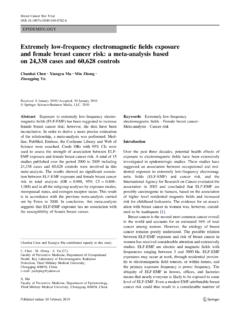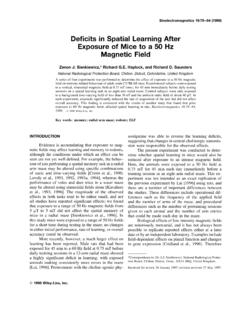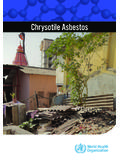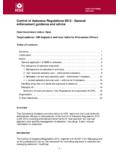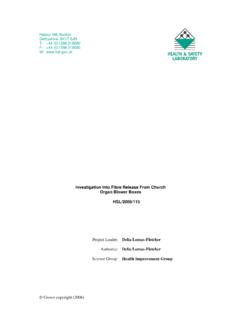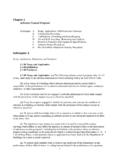Transcription of Is the Risk Comparison Made by the Public Between …
1 ARTICLEIs the Risk Comparison Made by thePublic Between EMF and Smoking orAsbestos a Valid One?KEN K. KARIPIDISA ustralian Radiation Protection and Nuclear Safety Agency, Victoria, AustraliaABSTRACTThe possibility of adverse health effects from exposure to extremely lowfrequency (ELF) electric and magneticfields (EMF) has caused considerablecontroversy in the scientific community and has received great attention in the mediaand among the general Public with many comparing ELF EMF with tobacco smokingand asbestos . Although both smoking and asbestos are now classified by theInternational Agency for Research on Cancer (IARC) as Group 1 or established carcinogens, this was not always the case. In this paper the evidence for thecarcinogenicity of ELF EMF is compared with that for smoking and asbestos using theBradford Hill model for establishing causality Between exposure and of the model shows that present data are insufficient to demonstratethat exposure to ELF EMF poses a definite human health hazard.
2 However, while thebulk of the evidence is weak, there are several epidemiological studies which havereported an association Between prolonged exposure to magnetic fields at levels abovewhat is normally encountered and an increased risk in childhood leukaemia. On thisbasis IARC has classified ELF magnetic fields as a Group 2B or possible : Electric and magnetic fields, smoking, asbestos , Bradford Hill criteria, cancerIntroductionThe use of electricity has continued to grow throughout the developed worldsince the first Public power station began operation over a century ago. InCorrespondence Address:Ken Karipidis, Electromagnetic Radiation Section, Non-IonizingRadiation Branch, Australian Radiation Protection and Nuclear Safety Agency, 619 LowerPlenty Road, Yallambie, Victoria 3085, Australia. Tel.:+61 3 9433 2282; Fax:+61 3 94321835; Email: of Risk ResearchVol. 10, No. 3, 307 322, April 20071366-9877 Print/1466-4461 Online/07/030307 16#2007 Taylor & FrancisDOI: present day, developing nations look to electricity as a primary means ofimproving the quality of life and creating jobs (Kheifetset al.)
3 , 2001). Whilethe countless benefits of electricity are undeniable, concern has been raisedabout the possibility of adverse health effects, and especially cancer, fromexposure to extremely low frequency (ELF) electric and magnetic fields(EMF) (WHO, 2001).Many among the general Public have labelled exposure to ELF EMF asthe new smoking or asbestos . Although the causal link Between these lattertwo agents and cancer now seems obvious, the connection was notestablished till the second half of the twentieth century. This long timedelay Between earliest use of these agents and the eventual proof of harmfuleffects has fuelled concern that ELF EMF could be a similarly harmful yetlargely unrecognised agent. The aim of this paper is to give a brief overviewof the scientific evidence surrounding these agents and apply the BradfordHill model for establishing causality Between exposure and disease todetermine whether the Comparison Between ELF EMF and smoking/asbestosis and asbestos Established CarcinogensSmokingTobacco was introduced into Europe at the end of the fifteenth century fromAmerica where it was mainly used for medicinal purposes.
4 It was during thesixteenth century that the practice of tobacco smoking through pipes spreadin Europe and throughout the world. Pipe smoking was eventually replacedby nasal snuff, followed by cigars and eventually cigarettes (Doll, 1998).Cigarette smoking became the dominant form of tobacco use in thedeveloped world in the early twentieth century after the introduction ofcheap, mass produced, cigarettes. Although the prevalence of smoking isdecreasing in developed countries, smoking is increasing in developingcountries with an estimated billion smokers worldwide (Edwards, 2004).Evidence that smoking tobacco causes adverse health effects has beenaccumulating for over 200 years, originally in relation to lip and mouthcancer, and then in relation to vascular disease and lung cancer (Doll, 1998,1999). The evidence was largely ignored until 1950, when Doll and Hill(1950), in England, and Wynder and Graham (1950), in the United States,published case-control studies that implicated smoking with the develop-ment of lung cancer.
5 A controversy developed over the credibility of thisfinding and was increased in 1954 when two independent large cohortstudies by Doll and Hill (1954), and Hammond and Horn (1988), supportedthe association with lung cancer. By the end of the 1950s, convincingevidence linking smoking with lung cancer and other cancers had beenobtained from several case-control and cohort studies and animal studieshad also shown that components of cigarette tar were carcinogenic (Vineiset al., 2004). In 1986 and more recently in 2002 expert Working Groups of308 Ken K. Karipidisthe International Agency for Research on Cancer (IARC) concluded thattobacco smoke is a multi-potent carcinogenic mixture that can cause cancerin many different organs and classified the agent as a Group 1 carcinogen tohumans (IARC, 1986, 2002a).Smoking is currently the single biggest avoidable cause of death anddisease in developed countries (Edwards, 2004).
6 The agent is currentlyresponsible for an estimated 30% of all cancer deaths in developed countries,and according to current smoking trends, a cancer epidemic attributable tosmoking is expected to occur in developing countries. In addition to cancer,smoking causes even more deaths from vascular, respiratory, and otherdiseases, so overall, smoking is estimated to account for approximately 4 5 million deaths a year, worldwide. This number is projected to increase tomore than 10 million a year by 2030, by which time 70% will be in developingcountries (Edwards, 2004; Vineiset al., 2004). Moreover, smokers are also atgreater risk of many other non-fatal diseases, including osteoporosis,periodontal disease, impotence, male infertility, and cataracts. Smokingduring pregnancy is associated with increased rates of foetal and perinataldeath and reduced birth weight for gestational age.
7 Although the evidence isweaker than for active smoking, involuntary, or passive, smoking is associatedwith cot death during infancy, respiratory disease in childhood and lungcancer, heart disease, and stroke later in life (Edwards, 2004).AsbestosAsbestos is a term used for a number of naturally occurring fibrous silicateminerals, which can be divided into two groups. Most common is theserpentine group, which is comprised of what is known as chrysotile second asbestos group, known as the amphiboles, has a series ofsubvarieties including crocidolite, anthophylite, actinolite, amosite andtremolite fibres (Niklinskiet al., 2004). The fibres have high tensile strength,and chemical, electrical and heat resistance properties that have madeasbestos extremely useful in commercial applications, especially inacoustical and thermal insulation. Inhalation of asbestos fibres can lead toserious diseases such as lung cancer, mesothelioma (a cancer of the lining ofthe lungs or lower digestive tract) and asbestosis (chronic fibrosis of thelungs).
8 asbestos has become the leading cause of occupationally relatedcancer mortality and is second only to tobacco smoking as the most lethalmanufactured carcinogen (Tweedale, 2002). Studies also show a multi-plicative interaction Between asbestos and smoking in the causation of lungcancer , the risk of lung cancer for a smoker exposed to asbestos is greaterthan the sum of the individual effects (Boffetta, 2004).The potential hazards to human health from asbestos were noted as earlyas 1899 but it was not until the 1920s that medical experts first described theill effects of inhaling asbestos fibres and named the condition asbestosis(Tweedale, 2002). The first cases of lung cancer among asbestos workerswere reported in the 1930s and the link with mesothelioma was first noted inEMF and Smoking or Asbestos309the early 1940s (Wood and Gloyne, 1934; Lynch and Smith, 1935). Sincethen numerous studies have described the carcinogenic effects of asbestosand at least two major multidisciplinary review panels have concluded thatall forms of asbestos fibres are associated with lung cancer andmesothelioma (Tossavainen, 1997; International Program on ChemicalSafety, 1998).
9 In 1977 IARC classified asbestos as a Group 1 carcinogen tohumans (IARC, 1977).Throughout the twentieth century, and especially since 1940, millions ofpeople have been occupationally and environmentally exposed to asbestos (Tweedale, 2002). Many cases of these diseases occurring now are a result ofexposure in industries which used asbestos extensively in the past. However,the fact that asbestos was also installed in many buildings means that awider range of people still have the potential to be exposed particularlybuilding and maintenance workers. It is expected that deaths caused byasbestos worldwide will rise to at least a million over the next 30 years,mainly due to cancer (Tweedale, 2002).Scientific Uncertainty About EMFELF EMF occupies the lower part of the electromagnetic spectrum in thefrequency range 0-3000 Hz. Exposure to ELF EMF arises mainly from thegeneration, transmission and use of electricity at the power frequencies of50 Hz or 60 Hz and common sources include power lines, electrical wiringand appliances, and industrial devices.
10 The widespread use of electricitymeans that people are exposed to ELF EMF in the home, in the environmentand in the workplace (WHO, 2001).In theory, the characteristics of ELF EMF make it an unlikely cause ofadverse health effects. In particular as ELF EMF is non-ionising, it hasinsufficient quantum energy to damage biological tissue through singlephoton interactions, and therefore, should not be capable of initiating cancerby the usual, DNA damaging, genotoxic mechanisms ,involving ionisation(Ahlbomet al., 2001). However, in 1979 an epidemiological study inDenver, Colorado by Wertheimer and Leeper (1979) reported an excess riskof leukaemia in children residing near so-called high-current configura-tions , power lines, transformers and devices characterised by a highcurrent. Since then, a large number of epidemiological and laboratorystudies have been conducted into a variety of diseases and exposureconditions to further investigate this unexpected result.
